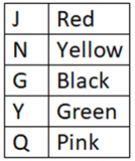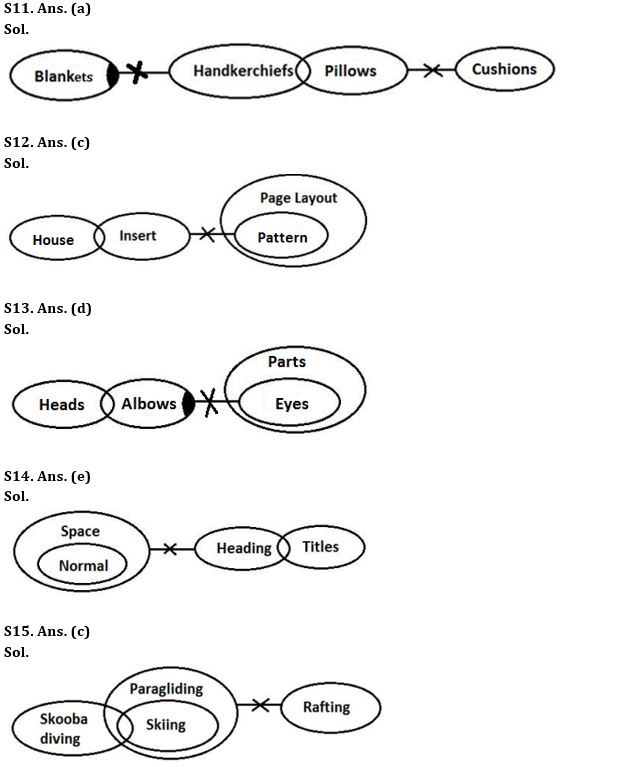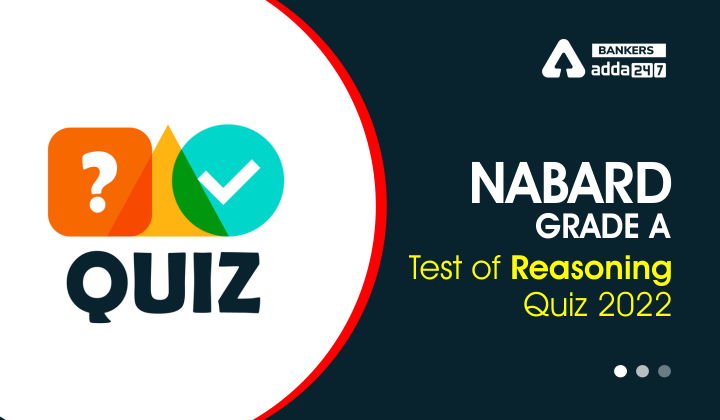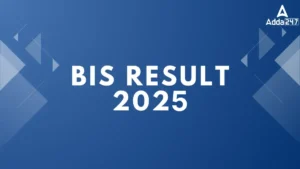Directions (1-5): Study the following information carefully and answer the questions accordingly.
Five boxes of different colors are placed one above the other in a stack. Y is not Black. J is placed immediately above N but is not Yellow. One box is placed between G and the Pink box. One box is placed between Y and the Yellow box. Q is not green. One box is placed between G and the Red box. Two boxes are placed between Yellow and the Pink box.
Q1. Which of the following boxes is green color?
(a) The box placed above N
(b) G
(c) The box placed at the bottom
(d) Y
(e) None of these
Q2. How many boxes are placed below N?
(a) Four
(b) Two
(c) One
(d) Three
(e) None
Q3. What is the color of the box placed between Y and N?
(a) Yellow
(b) Black
(c) Green
(d) Pink
(e) None of these
Q4. Which of the following boxes is placed at the top?
(a) Yellow box
(b) Y
(c) Q
(d) Red box
(e) None of these
Q5. Which of the given combination is correct?
(a) N – Red
(b) Q – Yellow
(c) G – Black
(d) J – Green
(e) Y – Pink
Directions (6-10): The following questions are based on the five four-digit numbers given below.
6982 3875 3267 4932 7568
Q6. If the first and fourth digits of each of the numbers are added, then the resulting sum of which of the following numbers will be the same?
(a) 4932, 3267
(b) 3267, 3875
(c) 3875, 6982
(d) 7568, 6982
(e) 6982, 7568
Q7. If all the digits of each of the numbers are added, then the resulting sum of which of the following numbers will be a prime number?
(a) 4932
(b) 3267
(c) 3875
(d) 7568
(e) 6982
Q8. If one is added to the last digit of each number and then the positions of the first and the fourth digits are interchanged, then which of the following will be the highest number?
(a) 4932
(b) 3267
(c) 3875
(d) 7568
(e) 6982
Q9. If in each number second and fourth digits are interchanged, then how many even numbers are formed?
(a) One
(b) Two
(c) Three
(d) Four
(e) None
Q10. If four digits arranged in descending order within the number then, what is sum of digits of second lowest number?
(a) 28
(b) 29
(c) 21
(d) 24
(e) 23
Directions (11-15): In the question below three statements are given followed by the conclusions. You have to take the given statements to be true even if they seem to be at variance with commonly known facts. Read all the conclusions and then decide which of the given conclusions logically follows from the given statements disregarding commonly known facts.
Q11. Statements: Some Blankets are not Handkerchiefs.
Only a few Handkerchiefs are Pillows.
No Pillows are Cushions.
Conclusions: I. Some Handkerchiefs are not Cushions.
II. Some Blankets are not Pillows
(a) Only I follows
(b) Only II follows
(c) Either I or II follows
(d) Neither I nor II follows
(e) Both I and II follow
Q12. Statements: Only a few House are Insert.
No Insert are Pattern.
All Patterns are Page Layouts.
Conclusions: I. Some House are Page Layout.
II. No House are Page Layout.
(a) Only I follows
(b) Only II follows
(c) Either I or II follows
(d) Neither I nor II follows
(e) Both I and II follow
Q13. Statements: Only a few Heads are Albows.
Some Albows are not Eyes.
All Eyes are Parts.
Conclusions: I. Some Heads are not Eyes.
II. Some Parts are not Albows.
(a) Only I follows
(b) Only II follows
(c) Either I or II follows
(d) Neither I nor II follows
(e) Both I and II follow
Q14. Statements: All Normal are Space.
No Space are Heading.
Only a few Headings are Titles.
Conclusions: I. No Normal are Heading.
II. Some Titles are not Space
(a) Only I follows
(b) Only II follows
(c) Either I or II follows
(d) Neither I nor II follows
(e) Both I and II follow
Q15. Statements: Only a few Skooba diving are Skiing.
All Skiing are Paragliding.
No Paragliding is Rafting.
Conclusions: I. Some Rafting are Skooba diving.
II. No Rafting are Skooba diving.
(a) Only I follows
(b) Only II follows
(c) Either I or II follows
(d) Neither I nor II follows
(e) Both I and II follow
Solutions
Solution (1-5):
Sol.

S1. Ans. (d)
S2. Ans. (d)
S3. Ans. (b)
S4. Ans. (d)
S5. Ans. (c)
S6. Ans. (c)
Sol.Clearly, 3875 and 6982 have same sum.
S7. Ans. (c)
Sol.Clearly, the sum of all digits of 3875 is prime number.
S8. Ans. (d)
Sol. Clearly, 9567 is the highest number which is formed from 7568.
S9. Ans. (b)
Sol.Clearly, two even numbers are formed.
S10. Ans. (e)
Sol.Clearly, the sum is 23.






 GA Capsule for SBI Clerk Mains 2025, Dow...
GA Capsule for SBI Clerk Mains 2025, Dow...
 The Hindu Review October 2022: Download ...
The Hindu Review October 2022: Download ...
 BIS Result 2024-25 Out for ASO, JSA and ...
BIS Result 2024-25 Out for ASO, JSA and ...





